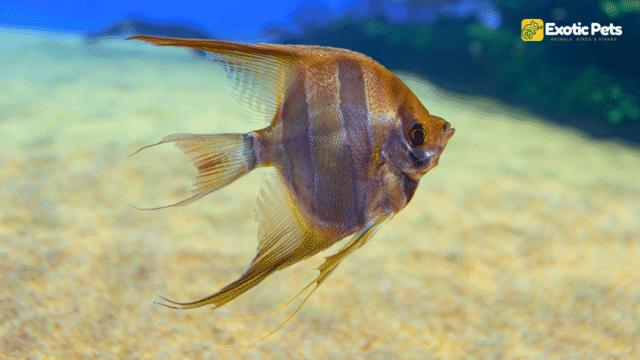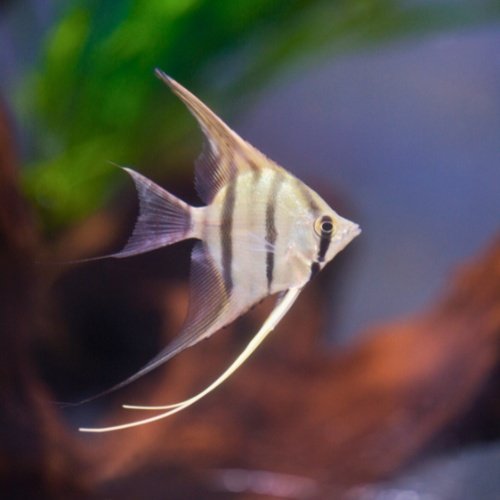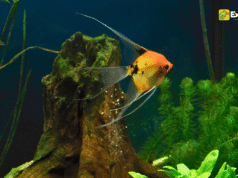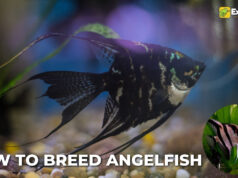
Freshwater angelfish (Pterophyllum species) are some of the most elegant and beloved fish in the aquarium hobby, known for their graceful, triangular bodies and flowing fins. These captivating fish originate from the Amazon River Basin, where they thrive in calm, slow-moving waters. Their beauty, peaceful nature and relatively easy care make them a favorite among aquarium enthusiasts.
In this comprehensive guide, we’ll cover everything you need to know about freshwater angelfish, including their origin, lifespan, care requirements, ideal tank environment, nutrition, breeding, ongoing care, and suitable tank mates.
Angelfish Breed Overview
| Name: | Angelfish |
| Family: | Pterophyllum Scalare (Cichlidae) |
| Size: | 6 inches |
| Care Level: | Moderately Easy |
| Tank Size: | 25 Gallons |
| Temperature: | 23 to 29 Degrees Celsius |
| Water Conditions: | Soft to Medium (5 to 7.5 pH) |
| Diet: | Omnivorous |
| Tank Size: | 25 Gallons |
| Temperament: | Peaceful |
The Origin and History of Angelfish
Angelfish, scientifically known as Pterophyllum scalare, belong to the genus Pterophyllum, a group of cichlids native to the tropical freshwater rivers of South America. They are primarily found in the Amazon River Basin, including rivers and tributaries in countries like Brazil, Peru, and Colombia.
History and Introduction to the Aquarium Trade:
Angelfish was first discovered in 1824 and brought to Europe in 1920. People in the U.S. started breeding it in captivity in the 1930s, and the fish are still on sale, but they differ from those that inhabit the wild. Their unique shape, striking colors, and peaceful demeanor quickly made them a popular choice among hobbyists. Over the years, selective breeding has resulted in numerous color varieties and fin types, further enhancing their appeal in the aquarium industry.
How Long Do Angelfish Live?

With proper care, freshwater angelfish can live 10 to 15 years in captivity, though some individuals have been known to live up to 20 years under ideal conditions. Their lifespan in the wild is generally shorter due to predators, disease, and environmental factors. The key to a long, healthy life for angelfish in captivity lies in maintaining optimal water quality, providing a balanced diet, and minimizing stress.
- In the wild: 10-12 years
- In captivity: 10-15 years, with exceptional care potentially reaching 20 years.
Types of Freshwater Angelfish
There are several popular varieties of freshwater angelfish, each with unique patterns, colors, and fin shapes. Here are some of the most common types of freshwater Angelfish:
- Silver Angelfish – The most common and classic variety, resembling wild angelfish with silver bodies and black vertical stripes.
- Marble Angelfish – Characterized by a marbled pattern of black, white, and sometimes gold on their bodies.
- Koi Angelfish – Named for their resemblance to koi fish, these angelfish display a mix of white, orange, and black markings.
- Veil Angelfish – Known for their extended, flowing fins, which give them a more dramatic appearance.
- Zebra Angelfish – Features bold, black vertical stripes on a silver body, similar to the Silver Angelfish but with more pronounced striping.
- Leopard Angelfish – Has a unique pattern of small, dark spots across its body, reminiscent of a leopard’s coat.
- Black Angelfish – Solid black in color, offering a striking contrast to the usual lighter varieties.
- Albino Angelfish – Features a pale, almost white body with red or pink eyes, lacking the typical pigments found in other angelfish.
Freshwater Angelfish Size Chart
The size of freshwater angelfish can vary depending on the species and the conditions in which they are kept:
| Type | Average Size | Max Size |
| Silver Angelfish | 4-6 inches (10-15 cm) | 6 inches (15 cm) |
| Marble Angelfish | 4-6 inches (10-15 cm) | 6 inches (15 cm) |
| Koi Angelfish | 4-6 inches (10-15 cm) | 6 inches (15 cm) |
| Veil Angelfish | 4-6 inches (10-15 cm) | 6 inches (15 cm) |
| Zebra Angelfish | 4-6 inches (10-15 cm) | 6 inches (15 cm) |
| Leopard Angelfish | 4-6 inches (10-15 cm) | 6 inches (15 cm) |
| Black Angelfish | 4-6 inches (10-15 cm) | 6 inches (15 cm) |
| Albino Angelfish | 4-6 inches (10-15 cm) | 6 inches (15 cm) |
Note: The sizes mentioned are from the tip of the nose to the end of the tail fin.
Setting Up the Ideal Tank Environment
Creating the perfect tank environment for your angelfish is crucial to their well-being and longevity. Here’s how to set up an ideal home for your angelfish:
Tank Size and Setup
- Minimum Tank Size: A minimum of 20 gallons is recommended for a pair of angelfish. If you plan to keep more or add other species, opt for a 30-gallon tank or larger.
- Substrate: A soft, sandy substrate is ideal, as it mimics the angelfish’s natural environment and prevents damage to their delicate fins.
- Filtration: Use a high-quality filter that provides gentle water movement. Angelfish prefer calm waters, so avoid strong currents.
- Lighting: Moderate lighting is sufficient. Bright lighting can cause stress, while dim lighting may hinder plant growth.
- Decorations and Plants: Include plenty of live plants, driftwood, and rocks to create hiding spots and replicate their natural habitat. Broad-leaf plants like Amazon swords are ideal, as they also serve as spawning sites.
Water Parameters
- Temperature: Maintain a temperature range of 75-82°F (24-28°C) to keep your angelfish comfortable.
- pH Levels: Angelfish prefer slightly acidic to neutral water, with a pH range of 6.5-7.5.
- Water Hardness: Keep the water hardness between 5-13 dGH.
Nutrition and Food for Your Angelfish
Angelfish are omnivores, requiring a balanced diet for optimal health and growth. A varied and balanced diet is essential for the health and longevity of your angelfish. Here’s what to feed them:
- Staple Diet: High-quality flakes or pellets specifically formulated for cichlids should be the primary food source.
- Protein Sources: Supplement their diet with live or frozen foods such as brine shrimp, bloodworms, and daphnia. These protein-rich foods support growth and enhance coloration.
- Vegetables: Occasionally offer blanched vegetables like spinach or zucchini to provide essential vitamins and fiber.
- Feeding Frequency: Feed your angelfish 2-3 times daily in small amounts, ensuring they consume all the food within a few minutes to prevent water contamination.
Breeding Angelfish
Angelfish are relatively easy to breed in captivity. They form monogamous pairs and lay their eggs on flat surfaces like leaves or slate. Provide a separate breeding tank with suitable water conditions and plenty of spawning sites. Breeding angelfish can be a rewarding experience, but it requires careful preparation and attention to detail.
Pair Formation
- Angelfish are monogamous and will form pairs, often choosing a lifelong mate. Once a pair forms, they will become territorial and may aggressively defend their space.
- It’s common to purchase a group of juvenile angelfish and allow them to pair off as they mature naturally.
Spawning
- Angelfish prefer to lay their eggs on vertical surfaces like broad-leaf plants, slate, or aquarium glass. They can lay up to 100-300 eggs in a single spawn.
- The eggs typically hatch within 2-3 days, and the fry become free-swimming after another 4-5 days.
Caring for Fry
- The parents will guard and care for the fry initially, but you may need to remove them if they become too aggressive or if other fish in the tank pose a threat.
- Feed the fry infusoria or finely crushed flakes until they are large enough to eat larger foods like baby brine shrimp.
Ongoing Care
To keep your angelfish healthy and thriving, ongoing care is essential:
Regular Maintenance
- Water Changes: Perform 20-30% water changes weekly to maintain water quality and remove waste.
- Tank Cleaning: Regularly clean the tank and equipment to prevent the buildup of algae and debris.
- Monitoring Water Parameters: Consistently test the water for temperature, pH, ammonia, nitrite, and nitrate levels. Keeping these parameters stable is crucial for the health of your angelfish.
Health Monitoring
- Disease Prevention: Be vigilant for signs of common diseases like Ich (white spot disease), fin rot, dropsy, anchor worms, and parasitic infections. Early detection and treatment are key to preventing outbreaks.
- Stress Management: Minimize stress by providing a stable environment, avoiding sudden changes in water conditions, and choosing compatible tank mates.
Appropriate Tank Mates
Selecting the right tank mates is vital to creating a peaceful and harmonious aquarium. Angelfish are generally peaceful but can be territorial, especially during breeding. Here are some suitable tank mates:
- Tetras: Larger tetras like Black Skirt Tetras or Rummy Nose Tetras can coexist peacefully with angelfish.
- Corydoras Catfish: These bottom dwellers are non-threatening and help keep the tank clean.
- Gouramis: Dwarf Gouramis are typically calm and make good companions for angelfish.
- Plecos: Bristlenose Plecos are a great addition as they help control algae and are not aggressive.
- Rainbowfish: Their fast swimming and peaceful nature make them compatible with angelfish.
Avoid: Small, fin-nipping fish like barbs and aggressive species like certain cichlids, as they can stress or harm your angelfish.
Final Thoughts
Freshwater angelfish are a fantastic addition to any aquarium, offering beauty, grace, and relatively easy care. By understanding their origins, providing the right tank environment, offering a balanced diet, and choosing appropriate tank mates, you can ensure your angelfish live long, healthy lives. Whether you’re a beginner or an experienced aquarist, angelfish are sure to bring life and color to your aquarium.










